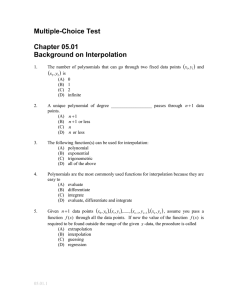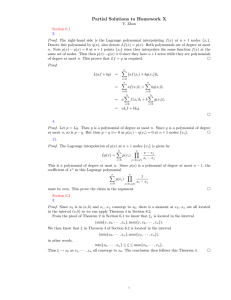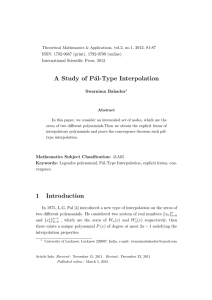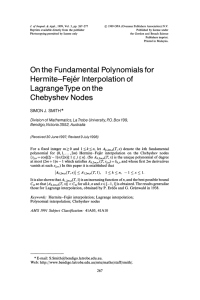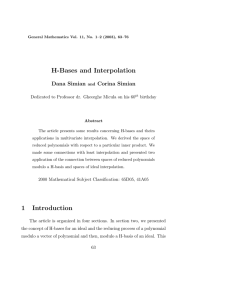RESEARCH NOTES ON OSCULATORY INTERPOLATION BY TRIGONOMETRIC POLYNOMIALS
advertisement
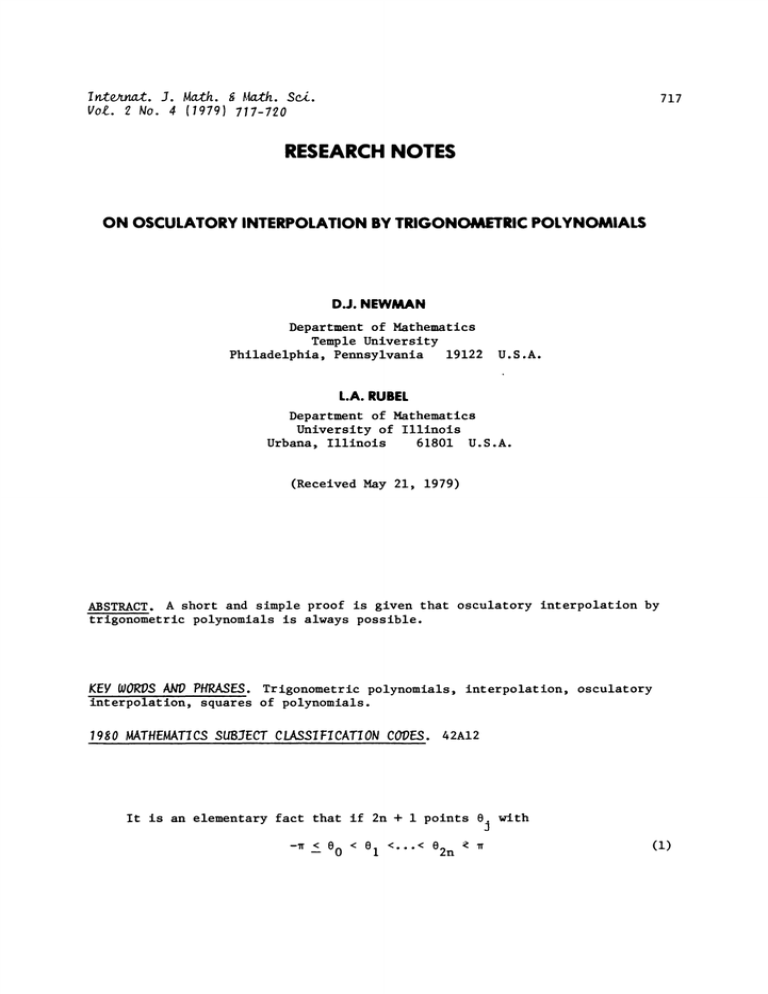
Internat. J. Math. Math. Sci.
Vol. 2 No. 4 (1979) 717-720
717
RESEARCH NOTES
ON OSCULATORY INTERPOLATION BY TRIGONOMETRIC POLYNOMIALS
D.J. NEWMAN
Department of Mathematics
Temple University
19122
Philadelphia, Pennsylvania
U.S.A.
L.A. RUBEL
Department of Mathematics
University of Illinois
61801
Urbana, Illinois
U.S.A.
(Received May 21, 1979)
ABSTRACT. A short and simple proof is given that osculatory interpolation by
trigonometric polynomials is always possible.
KEV WORS AN PHRASES.
Trigonometric polynomials, interpolation, osculatory
interpolation, squares of polynomials.
1980 MATHEMATICS SUBJECT CLASSI FI CATI ON CODES. 42A12
-
It is an elementary fact that if 2n
<
80 < 81
+
i points
<...<
82n
8j
wth
(].)
718
D.J. NEWMAN AND L. A. RUBEL
are given, then there exists an element
polynomials of degree
n
(ei@)
I
kz-n
f(e
iSj)
Tn
the class of trigonometric
<_n;
f
so that
of
f
w.
for
sequence of complex numbers.
ake
0,1,...,2n,
j
ik8
(2)
where
is any given
Wo,Wl,...,w2n
A proof (in the real case) is given in Example 5
on page 38 of Davis’ book [i], and on page 53, Problem 13 asks, somewhat
enigmatically, "Discuss the possibility of osculatory trigonometric interpolation."
In this note, we give a simple proof of a theorem that answers this problem and
a bit more.
THEOREM.
Given two sets of
complex numbers,
n
there exists a trigonometric polynomial
f(e
iej
w.
REMARK.
to letting the
f’(e
and
iej
w
for
f
j
of the form
J
coalesce in pairs.
2),
with
0.
Our theorem amounts
a
0
0, so that
1,2,...,n.
The osculatory case is where all the
@
Wl,’... ,wn,’
and
Wl’’’’’Wn
w.
Our proof depends on a trick that does not
seem to cover more general kinds of coalescence, for which there is surely a
corresponding result.
The lemma we use to prove the theorem sheds a little light
on the problem considered in [2-4] about the number of vanishing coefficients in
the square of a polynomial.
PROOF OF THE THEOREM.
O
Tn
Let
I0
n
is a vector space of dimension
be the subclass of
2n, and consider the
O
consisting of point evaluations of elements of
Tn
point evaluations of their first derivative at the
Tn
2n
at the
e
0, so that
0
linear functionals
where
and also of
e
j
a
l,...,n.
By standard
considerations of linear algebra it is enough to prove that these functionals are
linearly independent, or equivalently, that if
for
j
l,...,n,
then
f
O.
f 6
TO
and if
Let us suppose we have such an
f(e
f.
3)
f’(e
=0
OSCULATORY INTERPOLATION BY POLYNOMIALS
719
i0
Now writing
z
for
e
z
P(z)
degree
n
e
b
n
n
coefficien
b
are at the distinct points
question.
LEMMA.
Let
b
Then the middle coefficient
circle.
PROOF.
m
be a polynomial of degree
Q
wit.h
Q2(z)
of
n
n
roots on the unit
does mot vanish.
Let
n
Q(z)
so that
q2(z
n
n
i0j
j=l
Hence, on
{Izl
1},
we have
=Z
j=l
(z-e
n
(z_eiOj
-
J-i
j=l
IQ(z)
2
A
(l-e
z
1.
q2(z)
z
n
where
n
A=--j=l
Now integrate both sides of (3) around
(dz)/(2iz)
to get
of
Q
The next lemma then settles the
roots on the unit circle.
n
with
P
wose
is the square of a polynomial
P
and are all double roots, we see that
of degree
2m
Since the roots of
0.
we have
[ bk, k
kO
is an algebraic polynomial of degree
satisfies
i},
2n
n
z f(z)= P(z)=
where
{[z
T
on the unit circle
(-e
-iOj ).
T
with respect to the measure
dO/2
D. J. NEWMAN AND L. A. RUBEL
720
Ab
Since
[A
I,
we see that
ACKNOWLEDGEMENT.
b
n
n
fT
IQ(z)
2
dz
2iz
# 0.
The research of the authors was partially supported by grants from
the National Science Foundation, numbers NSF-550-34901 and NSF-MCS-78-OI417
respectively.
REFERENCES
i.
Davis, P. J.
2.
ErdSs, P.
3.
Rnyi, A.
.Interpolation and Approximati0.n., New York, 1963.
On the number of terms in the square of
v. Wisk., 23(1948), 63-65.
a.
polynomial, Nieuw. Arch.
On the minimal number of terms of the square of a polynomial,
Hungarlca Acta Mathematica, i(1947), 30-34.
4.
Verdenius, W. On the number of terms of the square and the cube of polynomials,
Indag. Math., 11(1949), 459-465.

